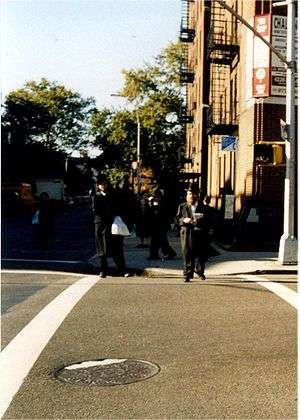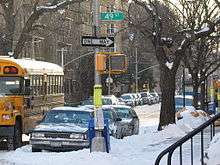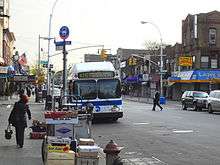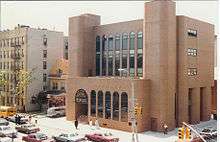Borough Park, Brooklyn
| Borough Park Boro Park | |
|---|---|
| Neighborhood of Brooklyn | |
| Nickname(s): "Baby boom capital" of New York City | |
 14th Avenue | |
| Country |
|
| State |
|
| City |
|
| Borough |
|
| Languages[1] | |
| Area | |
| • Total | 2.071 sq mi (5.36 km2) |
| Population (2010) | |
| • Total | 154,210 |
| • Density | 74,000/sq mi (29,000/km2) |
| Demographics 2013[2] | |
| • White | 69.35% |
| • Black | 4.30% |
| • Hispanic (of any race) | 4.90% |
| • Asian | 13.89% |
| • Other | 7.56% |
| ZIP codes | 11204, 11218–11220 |
| Median household income | $37,438[3] |
Borough Park (also spelled Boro Park) is a neighborhood in the southwestern part of the borough of Brooklyn, in New York City in the United States. The neighborhood covers an extensive grid of streets between Bensonhurst to the south, Bay Ridge to the southwest, Sunset Park to the west, Kensington to the northeast, Flatbush to the east, and Midwood to the southeast.
Borough Park is home to one of the largest Orthodox Jewish communities outside of Israel, with one of the largest concentrations of Jews in the United States, and Orthodox traditions rivaling many insular communities.[4] As the average number of children in Hasidic and Hareidi families is 6.72, Borough Park is experiencing a sharp growth in population.[5] It is an economically diverse neighborhood.[6]
History
Early development and railroads
Originally, the area was called Blythebourne, a small hamlet composed of cottages built and developed in 1887 by Electus Litchfield,[note 1] and then expanded with more housing by developer William Reynolds.[7][8] It was served by the Brooklyn, Bath and Coney Island, a steam railroad that is today's elevated BMT West End Line; the line ran from Greenwood Cemetery to Coney Island when it was built in the 1860s. This line was put on an elevated structure in 1917.[9]
The Sea Beach Railroad was another steam railroad. This railroad was named after the Sea Beach Palace Hotel, its southern terminal in 1879. In 1913, it was electrified and placed in an open cut.[9]
In 1902, State Senator William H. Reynolds bought the land northeast of Blythebourne. The new area was then named Borough Park. Blythebourne was absorbed into Borough Park by the 1920s.[10]
Jewish settlement

Jewish immigrants began populating Borough Park at the turn of the 20th century, beginning in 1904–05.[11] Through the 1930s, 13th Avenue was lined with pushcart vendors[12] and pickle sellers.[13] In the late 1930s the city opened a public market on 42nd Street to force an end to the pushcart trade. Thirteenth Avenue gentrified into an avenue of specialty shops interspersed with regular merchandise stores, and the avenue itself turned into a place "to see and be seen".[14]
In the 1980s, the neighborhood changed demographically from one of Italian, Irish, and Modern Orthodox Jewish to Hasidic Jewish families. By 1983, an estimated 85 percent of the residents of Borough Park were Jewish.[15]:101 New shops and restaurants opened on 13th Avenue to serve the expanding Haredi community. In 1987, two of the most popular stores debuted: Eichler's Judaica bookstore and Kosher Castle Dairy Cafeteria. New stores also opened selling imported goods and computer technology.[15]:108–109 At the end of the 1990s, businesses began selling electronics and Jewish books, music and videos to overseas customers via the Internet.[11] The area continued developing into a very large Jewish enclave around that time period.[4]
"Baby Boom Capital" nickname
In a 2000 Census study, it was reported that an estimated 76,600 Jews lived in Borough Park.[16] Since that time, Borough Park has grown significantly, and has earned the title of "baby boom capital" of New York City because of its high birth rate. The population in 2011 was 140,000. The neighborhood recorded 4,523 births in 2004,[17] the highest in the city. The closest Brooklyn neighborhood in terms of population growth was Williamsburg, home to many Satmar Hasidim, which reported 3,839 births. Borough Park's birth rate, 24.4 per 1,000 residents, has translated into major growth in the neighborhood.
Many of these births occur at Maimonides Medical Center, a hospital in the Borough Park area. The Maimonides Infants & Children’s Hospital of Brooklyn is fully accredited as a "children’s hospital within a hospital", one of three such facilities in New York City.[18] Here, at The Stella and Joseph Payson Birthing Center, Maimonides handles more births than any other hospital in New York State.[19]
The size of many Hasidic families often requires larger homes, and this has fueled construction and renovation projects across the neighborhood. The vast majority of these projects involve larger bedrooms and kitchens. Since 1990, the Building Department has issued more permits for private construction projects - new homes and additions - in the Borough Park area than in any other residential neighborhood in Brooklyn."[6] These construction projects were aided with a new law passed in 1992, which established Borough Park as a special zoning district where residents could build on 65% of their lot. This reduced the size of setbacks and backyards tremendously.
Business development

Thirteenth Avenue, a commercial strip roughly one mile in length from 39th street to about 55th street, is packed with storefronts supplying Jewish households. Many Hasidic Jews shop loyally at these stores, coming from all parts of the city, other states, and even other countries to buy kosher items. Businesses have benefited from the growing Jewish population, the increasing density of the neighborhood, and the use of entrepreneurial spirit on the Internet.[20]
The community receives many visitors, especially among Israeli expatriates and tourists. In 1987, The Park House Hotel opened its doors between 12th and 13th Avenues on 48th Street as the first kosher Hotel in Borough Park. In 1999, a kosher hotel called "The Avenue Plaza Hotel" opened on 13th Avenue, becoming the first hotel to appear in the neighborhood in more than a decade. These hotels are popular attractions for visitors to New York City, and they are among the few hotels that can accommodate the needs of many Hasidim.
Banks include HSBC (formerly Republic National Bank formerly Bank Leumi), Washington Mutual (formerly Dime Bancorp, and now part of JPMorgan Chase), and Citibank, all with local branches for decades. A booming economy has brought in others including Apple, North Fork now Capital One, Sovereign Bank (formerly Independence Community, now part of Santander), JP Morgan Chase, Berkshire, Liberty Pointe, Astoria, TD Bank, formerly Commerce Bank, Dime Savings Bank of Williamsburgh, Metropolitan National Bank, Valley National Bank, and Bank of America.
Education

The New York City Department of Education operates Borough Park's public schools; NYCDOE's District 20 covers Borough Park.[21] P.S./I.S. 180 Homewood School, a zoned public K-8 school, receives many bused-in students from other neighborhoods, including Bay Ridge and Bensonhurst. Many elementary schools have had mixed results from this student drain; for example, in 2004, a New York Times reporter stated that Public School 164 was "at only 89 percent of capacity because many children in the community attend yeshivas. Classes are small, the hallways quiet, the principal and assistant principal know every student by name."[22] Subsequently, the percentage of children reading at or above the grade level has increased to 55% in 2004 from 40% in 1998 in an otherwise unchanged school.
Most Borough Park neighborhood parents send children to Jewish private schools (called yeshivot).[23] In fact, virtually all the large population of school-children born into Borough Park's Hasidic families attend local yeshivas for boys and Bais Yaakov-type schools for girls. This had diminished the student population of local schools, such as The Montauk Intermediate School. The New York City Department of Education hoped to take advantage of the empty space and construct a small school, called the Kingsborough Early College School, inside Montauk.[24] The Hasidic community was not pleased by the prospect of a new public school because it would bring "a bad element" (a supposed euphemism for immodestly attired girls), and protested the decision. The Community Educational Council heard these complaints and decided against expanding its public school system. Instead, an all girls 6-12 school, the Urban Assembly for School for Criminal Justice moved in, and occupies part of the 3rd floor and the entire 4th floor of the building with its over 500 girls. In addition, The Montauk School now serves mostly Asian students; and nearly a third of its nearly 1000 students are English as a New Language students. Together, the schools service nearly 1600 students, above the target capacity of 1422 students.[25][26]
Police

The Hasidic community has developed a network of residents to handle emergencies in the neighborhood. Hatzolah is a volunteer ambulance group composed of emergency medical technicians and paramedics.[27] Brooklyn South Safety Patrol Shomrim is a citizens watch group that is sanctioned by the New York City Police Department (NYPD) community affairs division. They respond to security related calls in the area, and are called upon by the NYPD to assist in searches for missing persons. The Hasidic community has been able to form ties with the local authorities. The neighborhood is under the 66th Precinct of the NYPD.[28]
Religion

Borough Park is home to many Hasidic groups, the largest being the Hasidic Bobov sect; the Belz, Ger, Satmar, Stolin, Vizhnitz, Munkacz, Spinka, Klausenburg, Skver, and Puppa communities also reside here, among others. There is a minority of Hareidi non-Hasidic Lithuanian Jews (typically called Litvish or Yeshivish), with a smaller number of Modern Orthodox Jews. There is also a large population of Yemenite Jews, many of whom immigrated in the early 1920s.
In Brooklyn, about 37% of Jews consider themselves Orthodox,[29] and Borough Park is often referred to as the "heartland" or "home" for New York's Orthodox Jewish population.[30] The neighborhood became largely Orthodox in the last 40 years, making a transformation sometimes referred to as "suburb to shtetl."[31]
During much of the early 1900s, the Jewish population in Borough Park, and Brooklyn as a whole, was part of a much more liberal-leaning voting block. However, many of these early Jewish families moved to the suburbs or other places around the city while more conservative Hasidic Jews (many of them survivors of the Holocaust and immigrant families from Eastern Europe) joined their neighborhoods. As a result, the overwhelming majority of the Hasidic population in Borough Park and Brooklyn introduced a more traditional Jewish religious lifestyle. A 2002 study by the UJA Federation-New York revealed that only 2% of Borough Park's Jews identified themselves as Reform Jews and nearly three-fourths identified themselves as Orthodox Jews.[32]
Religious observances
The Hasidic population adheres strongly to halakha (Jewish law) and the Shulkhan Arukh (halakhic code), following many Judaic laws in their daily lives. Saturday is the Shabbos (Yiddish pronunciation of Hebrew shabbat, Jewish Sabbath), a day of rest, which is strictly observed by most members of the community. In some areas, a siren is sounded on Friday before sundown to indicate the arrival of the Shabbos. Culturally and religiously, the Jewish population of the neighborhood is considered one of the most Orthodox in the world, as "[m]any families do not own televisions or attend movies. The children attend yeshivas instead of public schools. Adolescent girls do not leave the house without making certain that their knees and elbows are covered, and at weddings and funerals alike, women and men sit separately to avoid physical contact, as required by religious law."[33] Additionally, most stores in Borough Park sell or prepare only kosher food made under rabbinical supervision. There was a large controversy surrounding the erection of an eruv in Borough Park, because of differing interpretations of the application of Jewish law. An eruv was built in 1999-2000 and encompasses about 225 blocks in Borough Park. Its use is still the subject of controversy. Mikvah's (Jewish ritual baths) are scattered across the neighborhood as it is considered a vital part of Orthodox Jewish life. It is rather difficult to identify as it is not usually explicitly advertised to promote privacy among its users.
Bobov
Borough Park is home to the headquarters of Hasidic Judaism's large Bobov community, numbering an estimated several thousand families.[34] It is one of Brooklyn's largest Hasidic communities and has followers in Canada, England, Belgium and Israel.
In 2005, the Bobover Rebbe, Rabbi Naftali Zvi Halberstam, died. A quarrel ensued over who should succeed him. The dispute was resolved by an arbitration panel known as a beth din, which decided that Rabbi Ben Zion Aryeh Leibish Halberstam, the former Rebbe's half-brother, retains all Bobov institutions. The faction that split created their own institutions and is headed by the former Rebbe's second son in law, Rabbi Mordechai Dovid Unger; the name of their institution is Bobov-45. In August 2014, the Beth Din prohibited the Bobov-45 group from using the name Bobov without an accompanying name, as in Bobov-45.
Transportation
The B8, B9, B11, B16, B35 New York City Bus routes serve the area, as well as the private B110 bus route to the predominantly Jewish neighborhood of Williamsburg. The New York City Subway's BMT West End Line, serving the D train, is at 55th Street, 50th Street, and Fort Hamilton Parkway. The IND Culver Line, serving the F train, runs along McDonald Avenue, the eastern border of Borough Park. The BMT Sea Beach Line on the N service also serves the neighborhood at Fort Hamilton Parkway.[35] Borogh Parks major avenues run north south, and run against Greenwood Cemetery. Its major shopping districts are 13th Avenue, 16th Avenue and 18th Avenue.
Health care and hospitals
Maimonides Medical Center has 679 beds, a full ER with a level 2 trauma center, maturity wards, and Psychiatric services. It includes a large outpatient clinics program and is a major teaching hospital in the state of New York.
Notable residents

- Chaim Zanvl Abramowitz, rebbe of Rybnitsa
- Helène Aylon (born 1931), multimedia ecofeminist artist.[36]
- Richard J. Bernstein (born 1932), philosopher, Vera List Professor of Philosophy and former dean of the graduate faculty at The New School.[37]
- Jay Black (born 1938), singer.[38]
- Yaakov Bleich, widely recognized as Chief Rabbi of Kiev and all of Ukraine
- Gidone Busch, police shooting victim
- Menachem Daum, Holocaust survivor and documentary film-maker
- Alan Dershowitz, law professor, litigator, and author
- Simcha Felder, New York state senator and former deputy comptroller for budget and accounting of the City of New York
- Joseph H. Flom, mergers & acquisitions lawyer
- Linda Weiser Friedman, professor and author
- David Geffen (born 1943), business magnate, producer and philanthropist.[39]
- Eli Gerstner, singer, songwriter and producer
- Buddy Hackett, comedian and actor
- Shraga Feivish Hager, also known as the Kosover Rebbe; rebbe of the Kosov Hasidic dynasty, dayan ("rabbinic judge"), and orator
- Ben Zion Aryeh Leibish Halberstam, the rebbe of Bobov
- Naftali Halberstam, fourth rebbe of Bobov
- Shlomo Halberstam, third rebbe of Bobov
- Shmuel Dovid Halberstam, the Sanz-Klausenberger Rebbe of Borough Park; younger son and one of the successors of Rabbi Yekusiel Yehudah Halberstam, the previous Klausenberger Rebbe
- Yitzchak Meir Helfgot, cantor
- Henry Hoschander, rabbi and lecturer
- Ahmed Ibrahim, the Cupid Cabbie of New York.
- Menashe Klein, rabbi of Ungvar
- Leiby Kletzky, 8-year-old Hasidic boy kidnapped, murdered and dismembered by Levi Aron in July 2011[40]
- Aharon Kotler, rabbi and prominent leader of Orthodox Judaism
- Sandy Koufax (born 1935), Hall of Fame major league baseball pitcher.[41]
- Moshe Koussevitzky, cantor and vocalist
- Chris Paciello, Cosa Nostra associate and nightclub owner
- Yisroel Avrohom Portugal, rebbe of Skulen
- Moshe Leib Rabinovich, rebbe of Munkacs
- Yossele Rosenblatt, cantor and composer
- John Saxon, film actor
- Arnold Schuster, clothing salesman and amateur detective, involved in the capture of bank robber Willie "The Actor" Sutton, and for subsequently being the victim of a gangland murder by the Gambino crime family
- Aaron Teitelbaum, rebbe of Satmar
- Moshe Teitelbaum, rebbe of Satmar
- Zalman Teitelbaum, rebbe of Satmar
- Mordechai Dovid Unger, rebbe of Bobov 45
- Osher Weiss, rabbi
- Mendy Werdyger, singer and songwriter
- Gavriel Zinner, rabbi and author of Nitei Gavriel
Notes
- ↑ His grandson, Electus D. Litchfield, continued as an architect and real estate developer.
References
- ↑ "Census data". Greenpoint Languages Spoken
- ↑ "Borough Park Demographics Data". 2012.
- ↑ "Borough Park Income in 2011". Retrieved 2011. Check date values in:
|access-date=(help) - 1 2 Barnes, Julian. "A Debate Over Strictures For Sabbath Observance", The New York Times. New York, N.Y. June 2, 2000. pg. B.1. Accessed May 9, 2016.
- ↑ Schick, Marvin. "A Census of Jewish Day Schools in The United States."
- 1 2 Sontag, Deborah. "Orthodox Neighborhood Reshapes Itself." The New York Times. January 7, 1998. pg. A1.
- ↑ Oscar Israelowitz, Borough Park, Centennial Edition 1898-1998, (Israelowitz Publishing)
- ↑ Kenneth T. Jackson and John B. Manbeck, The Neighborhoods of Brooklyn, (Yale University Press) 1998.
- 1 2 Borough Park, Forgotten NY
- ↑ Map and Photos of Borough Park
- 1 2 Roane, Kit R. (22 August 1999). "For Jews Around World, Borough Park Is the Place to Shop". The New York Times. Retrieved 24 December 2012.
- ↑ Drattell, Alan (2010). Once Upon My Time...: The Life of Alan Drattell: A Memoir. Xlibris Corporation. p. 26. ISBN 145008463X.
- ↑ Sontag, Deborah (7 January 1998). "Orthodox Neighborhood Reshapes Itself". The New York Times. Retrieved 24 December 2012.
- ↑ Breines, Estelle B. (2011). Brooklyn Roots: A Tale of Pickles and Egg Creams. iUniverse. pp. 4–5. ISBN 1450264050.
- 1 2 Mintz, Jerome (1992). Hasidic People: A Place in the New World. Harvard University Press. ISBN 0674381157.
- ↑ "In the Land of Black Coats". The New York Times. 2008-04-20. Retrieved 2015-10-02.
- ↑ Campanile, Carl (2006-01-23). "FERTILE GROUNDS - BABY BOOM IN BOROUGH PARK". New York Post. Retrieved 2015-10-02.
- ↑ http://www.maimonidesmed.org/Main/ClinicalServices/Pediatrics_Infants_Childrens_Hospital_85.aspx
- ↑ Hartocollis, Anemona; Fessenden, Ford (June 25, 2010). "Brooklyn Mothers Choosing Manhattan Hospitals". The New York Times.
- ↑ Roane, Kit R. (22 August 1999). "For Jews Around World, Borough Park Is the Place to Shop". The New York Times. Retrieved 25 December 2012.
- ↑ "District 20." Insideschools.org. Retrieved on November 15, 2008.
- ↑ Purnick, Joyce. "Schools Find New Test, For Themselves.", The New York Times. April 5, 2004. p. B1
- ↑ "Ps/Is 180 Homewood School." Insideschools.org. Retrieved on November 15, 2008.
- ↑ Gootman, Elissa. "Plans for a Public School Upset Brooklyn Hasidim." The New York Times. February 3, 2006. p. B3
- ↑ NYCDOE, "NYCDOE Blue Book, Capacity and Utilization Report.", Accessed=Jan. 17, 2016
- ↑ NYCDOE, "NYCDOE Montauk School Page", Accessed=Jan. 17, 2016
- ↑ http://select.nytimes.com/gst/abstract.html?res=F20E1EFC395D0C778CDDAD0894D1494D81
- ↑ NYPD Precinct 66
- ↑ Heilman, Samuel C. "The Young and the Restless.", [Op-Ed] The New York Times. April 9, 2006. pg. 4.13.
- ↑ Walzer, Robert (1999-02-14). "If You're Thinking of Living In / Borough Park, Brooklyn; For Many Orthodox Jews, a Heartland". The New York Times. ISSN 0362-4331. Retrieved 2016-01-20.
- ↑ "The Devout Raise a City Within a City And Prosper" The New York Times, September 15, 1995
- ↑ Newman, Andy. "In Orthodox Borough Park, Last Holdouts Get Strange Looks; Reform Jews, Adrift in a Sea of Black Hats.", The New York Times. May 13, 2005. pg. B1(Local)
- ↑ Confessore, Nicholas, Farmer, Ann. "In Borough Park, the Unusual Taste of Fear.", The New York Times. May 10, 2006. pg. B.3
- ↑ Newman, Andy. "A Battle for Succession Takes No Holiday.", The New York Times, March 26, 2005 p. B4 col 01 (19 col in)
- ↑ http://web.mta.info/nyct/maps/busbkln.pdf
- ↑ Vox Tablet. "Helène Aylon’s Journey From Rebbetzin to Internationally Acclaimed Feminist Artist; The irreverent 82-year-old left Orthodox Borough Park long ago. But she’s still wrestling with the rituals of her past.", Tablet (magazine), September 9, 2013. Accessed May 9, 2016.
- ↑ Bernstein, Richard J.; Benhabib, Seyla; and Fraser, Nancy. Pragmatism, Critique, Judgment: Essays for Richard J. Bernstein, p. 331. Accessed May 9, 2016. "The youngest of two children, two boys and a girl, he grew up in Borough Park, a primarily lower-middle-class section of Brooklyn."
- ↑ Eliot, Marc. Song of Brooklyn: An Oral History of America's Favorite Borough, p. 49. Crown/Archetype, 2008. ISBN 9780767929998. Accessed May 9, 2016. "Jay Black, the leader of the group, was also born and grew up in Brooklyn. Because of the way he looked, with his greased-back hair and his neo-operatic voice, everyone thought he was Italian, which was a good thing since most of the bands were either black or Italian, but he was actually Orthodox Jewish from Borough Park."
- ↑ Handelman, David. "How David Geffen Got Ahead: Lies, Loot and a Little Luck", New York Observer, March 13, 2000. Accessed May 15, 2016. "David Geffen grew up in Borough Park, Brooklyn, the son of a mother who made custom brassieres and a father who didn’t do much of anything."
- ↑ Baker, Al; Robbins, Liz; Goldstein, Joseph (13 July 2011). "Missing Boy's Dismembered Body Found; Suspect Says He Panicked". The New York Times. Retrieved 13 July 2011.
- ↑ Bush, Daniel. "There’s more to Jewish baseball than Sandy Koufax", The Brooklyn Paper, May 4, 2012. Accessed May 15, 2016. "Ephross said he didn’t try to contact Dodgers legend and Borough Park native Sandy Koufax, but promised the book packs some series heat despite leaving out the notoriously reclusive Hall of Fame flamethrower."
| Wikimedia Commons has media related to Borough Park, Brooklyn. |
Coordinates: 40°38′01″N 73°59′34″W / 40.6335°N 73.9929°W

